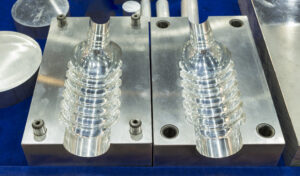Intro
Understanding the different mold options for your injection molder is a quick way to save time and money during each production run. Two of the more popular ways to create multiple parts at once are family molds and multi-cavity molds.
In this guide, we’ll explain the difference between these two mold options. In the end, you’ll learn which option is perfect for you.
What Is a Multi-Cavity Mold?
Let’s start with some definitions. As you might know, family molds and multi-cavity molds are both ways to create multiple parts at once in an injection molding machine. Either of these molds is loaded into the machine, filled with molten plastic, cooled, then the final plastic part is extruded from the mold.
As the name suggests, a multi-cavity mold has multiple cavities. The cavity is what fills with plastic in order to create the final part.
In other words, a multi-cavity mold has a lot of different slots that will fill with plastic and create a single unit, each. The mold will fill each cavity at the same time, allowing you to make multiple, identical units with a single shot.
What Is a Family Mold?
Family molds work in a very similar manner as multi-cavity molds, but there’s one big distinction: with family molds, each cavity is different and creates a different part. What does that mean? Well, multi-cavity molds will create multiple identical units each cycle, but family molds create different parts in each cycle.
Family molds are commonly used to create assemblies out of plastic. If you have a multi-part enclosure, then you can create all of the parts at once in a family mold, as opposed to loading four different molds to create the four different parts. It ensures that your inventory always has a full assembly without the need to do math to keep things on track.

Differences Between Family and Multi-Cavity Mold
In order to understand which injection molding option is right for you, let’s discuss the main differences between family and multi-cavity molds.
Creating Different or Identical Parts
Family molds are the right option if you need to create different parts in a single injection molding cycle, since each cavity is different. Multi-cavity molds are perfect for creating multiples of the same part within the same process.
If you need to create a full assembly, having a family mold is a no-brainer.
Production Volume
Let’s look at the actual volume that you can produce with either of these mold options. With multi-cavity molds, you are multiplying your production volume based on how many cavities you have in the mold. If you can squeeze 6 cavities into a single mold, your production rate will multiply by 6.
Family molds are definitely faster than making each part of the assembly separately, but you’re still only left with 1 assembly after the full injection molding process (since multiple parts go into 1 assembly).
Total Cost Per Unit
On paper, both family and multi-cavity molds are roughly the same when it comes to tooling and upfront costs. However, you’ll see a slight cost savings when you look at a multi-cavity mold over time. Since you’re making the same unit each time, your per-unit cost goes down much faster than it does in a family mold.
Flexibility in Design
Multi-cavity molds are a lot simpler to design and create. After all, you’re basically copying and pasting one cavity multiple times in a single mold.
With family tooling, things can get a lot trickier. You’ll need to space out the different designs and look into the right way to lay everything out within the mold.
Maintenance and Tooling Requirements
When you look at long-term costs associated with maintenance and tooling requirements, multi-cavity molds are the clear winner. Speaking from experience, multi-cavity molds are significantly easier to clean, maintain, inspect, and even repair.
This goes back to the fact that multi-cavity molds have simpler designs and implementation than family molds.
Final Part Quality
The final part quality can vary a lot within a family mold. If the units are different sizes, then they will fill and cool unevenly compared to other parts within the same mold. This alone can lead to dramatic differences in the final part quality between two parts within the same mold.
Multi-cavity molds offer more consistency. Once you dial in the pressure and temperature of the plastic, then you’ll lock in the quality for every part you make within the mold. The same is not true for family molds.
Should You Use a Family or Multi-Cavity Mold?
Speaking generally, multi-cavity molds are typically less expensive to run long-term, require less maintenance, and speed up your production. They are the go-to option for anyone who has a single SKU (or product) that they need to make. Multi-cavity molds offer an opportunity to create more units during each injection molding process.
Family molds, on the other hand, are the clear winner if you’re making multi-part assemblies. Having all of the parts come out in a single shot is much simpler and makes inventory management a breeze. In many cases, you can create a plastic spine that connects all the pieces together, keeping the assembly whole during transport.
Conclusion
Our injection molding experts at Rapid Axis just described the difference between family and multi-cavity molds. We’ve created countless parts through our in-house injection molding machines, and we can help you too. Whether you need a family mold or multi-cavity mold, allow our team to help you from machining to injection molding, and everything in-between. Get a free quote today.
